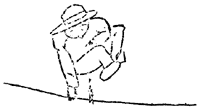|
Volume I No. 3 - September 1, 1928
A Rare Fern From Crater Lake
By F.L. Wynd
Dept. of Botany, University of Oregon
Crater Lake seems to be an especially favorable locality for the
bizarre and unusual plant life. Besides the seven new species that
Colville found in this region in 1896, he has since described another.
(In Underw. Nat. Ferns ed. 669, 1900). This is a little fern that grows
only on the highest pumice slopes. It really is not a true fern since
the fronds are not circinate in the bud, the sporangia do not have
typical fern's annulus, and the spores are formed within the tissue of
the sporophyll. By these characteristics we place it in the Adder's
Tongue Family (Opheoglossaceae) but still for all practical
purposes we may call it a fern.
Its extreme rarity is evidenced by the fact that it has been found
by collectors only twice. The type specimen was found a good many years
ago, but since then it has "hidden out" on us completely, with the
single exception of a specimen which was collected this season.
Not only its rarity, but also its protective coloration aids it in
escaping notice. The leaves, or fronds, are a dull grey color, which
blends perfectly with the pumice slopes on which it grows. This is a
fortunate circumstance, since it would soon become extinct were it at
all conspicuous.
Botanists call this plant Botrychium pumicola, which altho
grammatically incorrect as Latin names go, means "pumice
inhabitant."

While relaxing peacefully with a bit of light literature under a
tall hemlock on a sunny slope, the writer was disturbed by the sharp
sensations such as an ant may impart. After the experience had been
repeated several times a casual search for the insects was begun, and
there were none. But the ground was found to be littered with several
dozen porcupine quills. A good collection was gathered as mementoes of
an experience which had previously been duplicated only with cactus, in
the deserts of the Southwest.
Porcupines are often noticed in the Park. Near the Community House
several fir trees show dead branches, and bark peeled off about thirty
feet above the ground, evidently the work of these rodents. A ranger
reports avoiding possible punctures while driving on the Rim Road late
one evening, by giving a porcupine ample time to decide to amble into
the woods instead of following down the roadway as it did for several
yards.
| 
